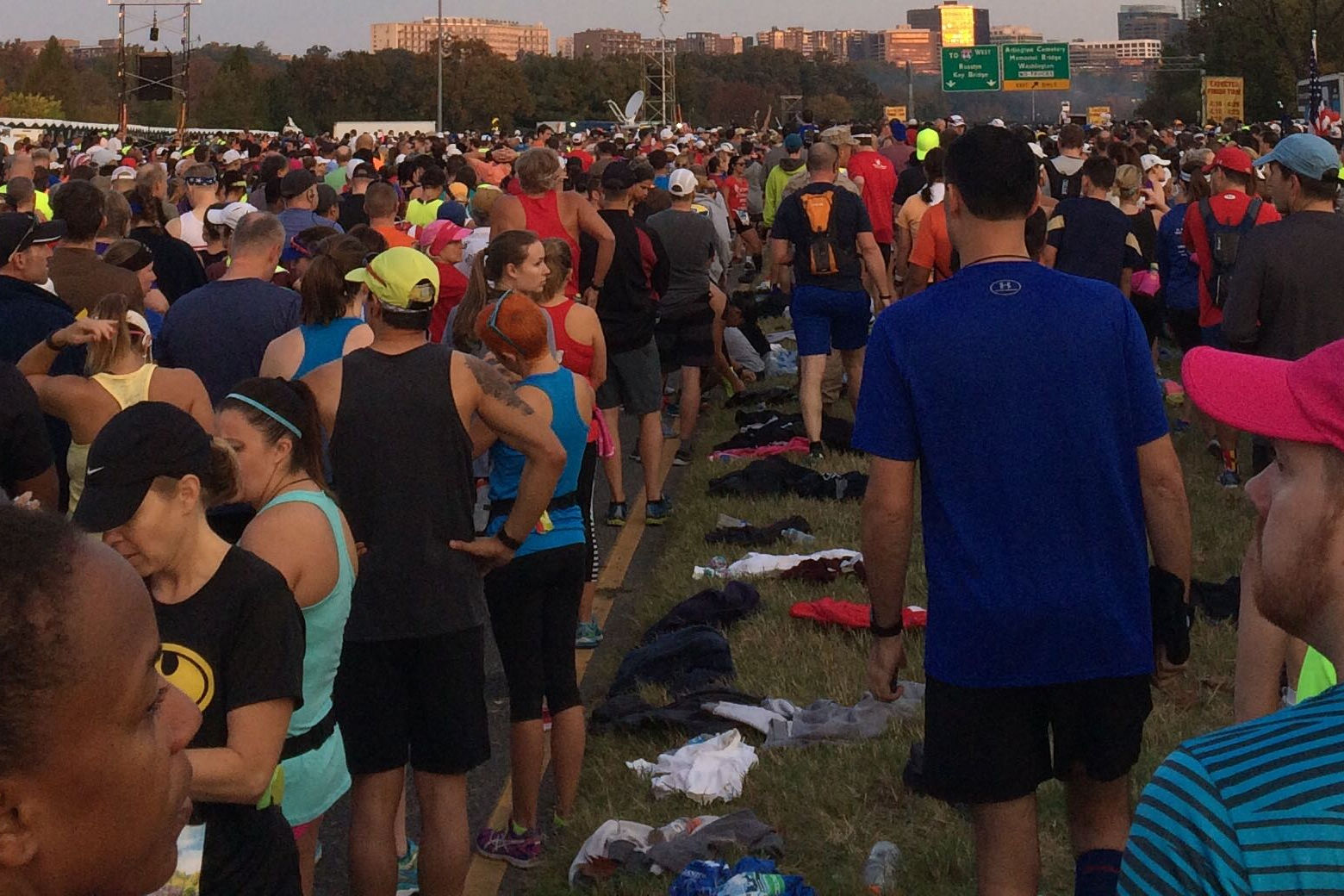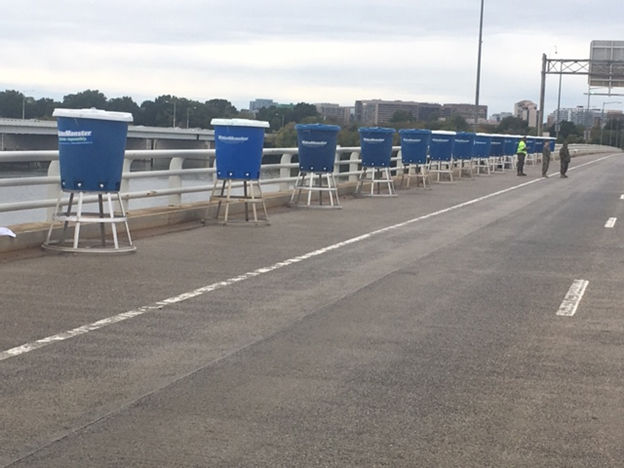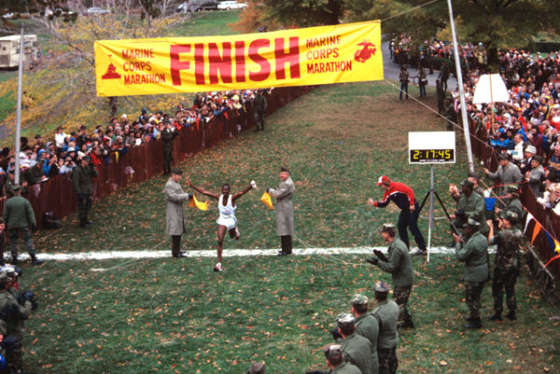
This Sunday, tens of thousands of runners will don running bibs, maybe a lucky pair of running shoes and assemble in Arlington, Virginia, for the 44th annual Marine Corps Marathon.
But if you look closely, many of the runners gathered in the dawn’s early light might look a little … strange.
”They put all kinds of funny clothes on,” said Angela Anderson, an experienced marathoner and the deputy director of the Marine Corps Marathon. “I was very surprised to see people with bathrobes coming down there, pajama pants, expensive running clothes that they then throw into the streets.”
It serves a purpose: Keeping runners warm before the start of the race. But as the minutes tick down to the howitzer blast that signals its start, many of them start shedding their comfy clothes.
The end result is tons of abandoned apparel piled up along the first few miles of the course. Literally. More than 2 1/2 tons of clothing were collected from the race route last year, according to race organizers.
And figuring out what to do with it all is Anderson’s job.
She leads the Marine Corps Marathon’s “greening team,” the group responsible for making the race more sustainable.
It’s not just the thousands of pounds of tossed-away clothing Anderson and her team have to deal with.
The “People’s Marathon” draws 30,000 participants and it’s standard 26.2-mile-long course curves in and out of D.C. and Virginia. Overall, the event generates nearly 7 1/2 tons of waste which Anderson’s team is responsible for making sure is properly recycled or composted and another 5 1/2 tons of cardboard, plastic and glass bottles, and food containers.
Without a lot of planning, the potential environmental impact is enormous.
Anderson’s efforts have more urgency this year.
The Council for Responsible Sport, which sets international sustainability benchmarks, will pay a visit to this year’s race to certify the sustainability efforts — essentially providing a grade for how green the marathon is.
More Marine Corps Marathon stories:
- Read profiles of some of this year’s runners
- Metro to open early for Marine Corps Marathon
- FAQ: Marine Corps Marathon’s 1st 50K race
- Here’s what you need to know about the 44th Marine Corps Marathon
The last time the Marine Corps Marathon’s sustainability efforts were evaluated three years ago, the race earned a certification of “Gold” — the second highest level. This year, Anderson and her team are pursuing the highest — “Evergreen.”
“We are working very hard and striving toward it,” Anderson told WTOP. “The main issue here is to minimize the carbon footprint. And we are trying to be very innovative, trying to find ways so we can meet those standards.”
Just a handful of sporting events around the world have reached the elusive Evergreen status, including the 2018 Chicago Marathon and the Mexico City Marathon.
For Anderson and her team, reaching the highest level of certification puts them in a behind-the-scenes competition with other high-profile sporting events.
“I mean, we are one of the largest marathons in the nation and in the world,” she said. “We share information with the other races … that are just as large as us. And we know what kind of certification they have and we, of course, want to compete with them and hopefully beat them in a friendly way.”
Here’s a look at the sustainability efforts undertaken by Anderson’s team in preparation for the 44th Marine Corps Marathon.
Thousands of pounds of clothing, banana peels
Last year, 5,280 pounds of discarded clothing were collected from the race route.
Once again this year, marathon organizers are working with a private company called the Clothing Recycling Company to collect, clean, sort and then donate the clothing to shelters in the D.C. area. The company might sound familiar — it maintains dozens of green donation bins all across the D.C. area.
On the racecourse, some of the jettisoned clothing still has a lot of mileage left in it. Anderson said one year she found a brand-new running jacket — with the tags still on it. “Of course, I didn’t keep it,” she said. “I gave it to the person to collect it. But it’s amazing what you find out there.”
In addition, visitors to the Marine Corps Marathon Health & Fitness Expo, held at the Gaylord Resort at National Harbor the day before the race, are encouraged to bring their old running shoes to donate them.
Shoes that are still in good shape are collected by a group called AmVets, which donates them to people in need, Anderson said.
If the shoes are particularly “high mileage,” the Nike Reuse a Shoe program grinds down the donated shoes into bits and pieces which are repurposed as cushy playground material.
Last year about 650 pounds of shoes were donated during the expo, Anderson said.
Marathon organizers are also working with Arlington County’s Solid Waste Bureau to make sure hundreds of pounds of banana and orange peels are composted properly. The healthy snacks are handed out during the race to keep runners nourished. But with 30,000 runners — it adds up quickly. Last year, 1,500 pounds of banana and orange peels were collected from points along the race route.
Enter the Water Monster
Anderson’s team is also getting creative about ways to avoid or reduce waste altogether, through the use of a cupless water station at a key point in the race.

After the marathon course cuts through D.C. and along the National Mall, it takes runners back into Virginia. And the clock is ticking. Runners have to clear the 14th Street Bridge heading back into Virginia by 1:15 p.m. on race day.
Beating the bridge is a crucial stretch of the race — and it’s also one of the most forbidding. There are few spectators cheering runners on and, being unshaded, it can often get very hot.
For the longest time, there was no water refill offered before this stretch of the race because setting up a traditional water station could have risked having cups blown — or thrown — into the river.
Enter the Water Monster: A giant, 125-gallon water tower outfitted with multiple spigots allowing runners to fill up their own reusable water bottles or hydration packs, such as Camelbaks.
The marathon first rolled out a series Water Monsters last year along the 14th Street Bridge. And it will do so again this year. The Water Monsters avoided the use of 48,000 cups, Anderson said.
After race, cleanup crews go to work
Cleaning up after the race is an important part of the sustainability efforts.
Groups of volunteers are assigned to nearly every mile of the race. They go to work as soon as the runners have crossed the finish line, clearing any waste or other debris.
Since the racecourse makes its way through Rock Creek Park, the teams that operate under the “Adopt-a-mile” program also play a key role in making sure none of the waterways are contaminated.
All told, it takes each group about an hour to clear their mile of the course.
“They make sure there’s nothing left out so that on Monday morning when we do a walk-through, everybody is happy,” Anderson said.









